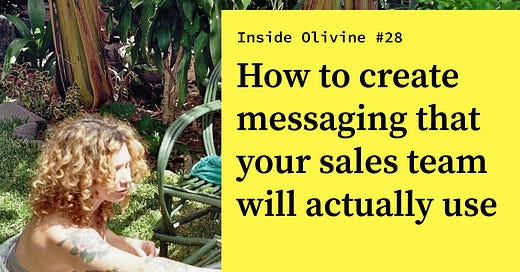Inside Olivine #28
💸How to create messaging that your sales team will actually use with Sheena Vega
👋Hola from Brooklyn, NY
Sheena here, Director of PMM at Olivine. I’m a salsa and bachata enthusiast and lover of these springtime vibez. If you’re in NYC and a fellow salsera/o or bachatera/o, shout out your favorite socials in the comments, and we can meet up for a dance!
Ok, now let’s talk about messaging –specifically, how to create messaging your sales team will actually use. Before I dive in, here’s a bit of background that qualifies me to write on this topic. Before I made the move into Product Marketing, I spent 10 years in sales, with over five years in B2B SaaS.
Back then, my fellow sellers and I often felt that the marketing materials we received were filled with jargon and fluffy language, making them hardly useful. We’d roll our eyes at the fact that marketing never asked for our input despite our strong customer relationships. Fast-forward to today, and I still hear similar complaints from salespeople. Product marketing teams struggle to get their collateral used by sales. So, I get it. I understand the frustration from both sides.
So let’s get into it. How can you create messaging that your sales team will actually use?
Prioritize Building a Strong Relationship With Your Sales Org
Before you dive into crafting messaging that resonates with your salespeople, you need to connect with them. This may sound obvious, but as product marketers, we invest so much time into our relationship with the product team that we inadvertently neglect our relationship with our sales partners. Every point in this newsletter hinges on the foundation of a strong rapport with sales—it's that important! If you need additional tips on how to do this, we wrote an entire newsletter on how to build better relationships with your sales partners last year, you can check it out here. Inside Olivine #14 - by Olivine Marketing
Understand Your Audience
Surprise, I’m not talking about your personas. I’m talking about your sales team. Building on my initial point, treat sales like your customer. As product marketers, we know our work relies on understanding our buyers and users. We take the necessary steps to dig deep and understand their pain points and motivations. If we want to create messaging and materials that sales will use, we have to be just as proactive with our sales team.
Get to know the challenges your salespeople are facing. Regularly meet with them to learn more about who they’re trying to reach and why. Incorporate these insights into your messaging and the collateral you create.
Develop Core Value Props Grounded in Real Customer Pain Points
Establishing a solid rapport with sales opens doors to direct customer insights. Sales holds the key to these invaluable relationships. Shadow their discovery calls, request recordings, and ask for customer introductions. Pay close attention to what customers are really saying about their challenges and pain points. Then, develop value propositions that align with solving them. By aligning your messaging with these customer-centric solutions, you'll create content that resonates with your sales team because it directly speaks to the conversations they're having.
Invite Top-Sellers into Your Working Sessions
Get top-sellers involved in your messaging development early. These individuals have extensive conversations with customers giving them a deep understanding of who they are and what their challenges are. Inviting top-sellers to your working sessions can save you from having to rework an entire messaging guide later. Plus, it will give you a champion on the inside. If the rest of the sales team knows one of their top-sellers contributed to messaging, they’re more likely to find it useful.
Use Customer Testimonials as Inspo
Customer testimonials, reviews, and interviews provide valuable insights for crafting effective messaging. They reveal where customers are actually finding value. Last year, we collaborated with a client who needed support with new value propositions. We ran customer interviews to validate their messaging, and what customers were saying differed significantly from what the product and marketing teams believed the value propositions to be. If you can't get customers on the phone for an interview, testimonials and reviews are an easy resource. Remember, sales is in constant dialogue with customers. If you create messaging that doesn't align with what their customers are saying, they won't use it.
Simplify Simplify Simplify
If you can say it in fewer words, do. If you can say it in simpler words, do. Create messaging that is clear, concise, and easy to consume. Fluffy jargon can be fun to write, but it’s also confusing to read. And, odds are your competitors are using jargon. Standout with simplicity. Make those elevator pitches easy to use because they are easy to remember and understand.
Collaborate With Sales Leadership on Training
I mentioned the importance of involving top-sellers early in the messaging development process. Now here’s a tip on messaging training. When you’re ready to train the sales team on any new messaging, start by collaborating with sales leaders. Train them first. At this point, you should have total buy-in because you’ve involved their team from the start. Share the messaging you’ve created, and enable sales leadership. Then, have sales leadership train their teams. This approach ensures that messaging is not only communicated effectively by a trusted leader but also embraced wholeheartedly by the sales team.
Measure, Optimize, and Share Results
Whether you're implementing fresh messaging on your homepage, striving to boost demo requests, or experimenting with sales pitches, it's crucial to test, refine, and communicate your results. Tools like Gong simplify tracking engagement across qualification, discovery, and sales pitch conversations, while platforms like Highspot measure engagement with customer-facing materials and presentations. Regardless of the tools you use, keep your sales team in the loop on the progress you’re making with prospects, customers, and conversions. This collaborative approach fosters transparency and ensures alignment.
To wrap up, well-crafted messaging that your sales team will use and value begins with cultivating strong relationships. Everything that follows, from inviting top-sellers into your working sessions to shadowing sales calls, interviewing customers, and collaborating with sales leadership on your rollout and training, relies on this foundational step. Establishing these relationships paves the way for easier access to customers and facilitates the creation of messaging that authentically connects with both your customers and your sales team.
Have another tip? We’d love to hear it. Drop it in the comments!
Top LinkedIn Post
Fresh Finds
Tool I love: OMG, right now, I’m totally obsessed with Riverside. It makes video content so easy! I didn’t realize I was a podcaster at heart, but apparently, I am.
Shallow dive: Check out this LinkedIn Profile Cheat Sheet by Angel Lau to up-level your profile and get noticed.
Inside Olivine
Content gems
Client happenings
IBM THINK was a tremendous success, and Loqate was delighted to be a part of it.
78 of the Fortune 100 companies use Smallstep's open-source software. Now, the creators offer commercial versions as a managed service.
Job Openings
Figma is hiring a Product Marketing Manager, Figma Editor
Muck Rack is hiring a Product Marketing Manager
Mercury is hiring a Head of Product Marketing
Arkose Labs is hiring a Product Marketing Manager
















Interesting POV on messaging and narrative. I too write on GTM strategies...
Here is the link.
StartupGTM.substack.com
Would love to know your feedback and explore collaboration opportunities.
Such great perspective and advice!